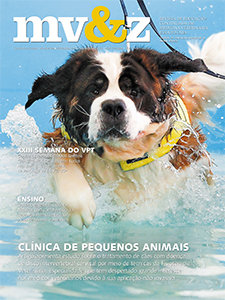Short-term hyperprolactinemia decreases allergic inflammatory response of the lungs
Conteúdo do artigo principal
Resumo
Purpose: the present study evaluated the effects of short-term hyperprolactinemia induced by domperidone before ovalbumin antigenic challenge on the lung’s allergic inflammatory response.
Materials and Methods: animals and experiment outline male rats aged 60 to 90 days old were divided randomly into four groups; a naïve group (N) with no treatment and no lung allergy; a control group (C), a vehicle group (V), and domperidone group (D) with induced lung allergy and respective treatments. On day 0, all animals of groups (C), (V) and (D) were injected with OVA and were boosted on day 7. Between days 10 to 14, group (D) was treated with domperidone as described previously, whilst group (V) was administered NaCl 0,9%. On days 15, 16 and 17, animals in groups (C), (V) and (D) received OVA in aerosol form to induce lung allergy. Allergic lung inflammation model in rats were sensitized by 10 μg ovalbumin (OVA; Egg Albumin Grade II) and 10 mg of aluminum hydroxide, dissolved in PBS (phosphate-buffered saline) and administered by subcutaneous injection (day 0) at a dose of 01 mg.kg-1. One week later (day 7), rats were boosted subcutaneously receiving the same treatment. For the challenge with OVA aerosol (1% in PBS) animals were individually placed in an inhalation chamber connected to an ultrasonic nebulizer for 15 minutes per day for three consecutive days (days 15, 16, 17). Experimental hyperprolactinemia to induce hyperprolactinemia, domperidone was injected in rats at a dose of 5.1 mg.kg-1 per day, i.p., for 5 days. Total and differential leukocyte counts from bronchoalveolar lavage (BAL), femoral marrow lavage (FML), and blood were analyzed. The percentages of mucus and collagen production were evaluated microscopically. Enzyme-linked immunosorbent assays were performed to measure serum corticosterona, adrenaline and prolactin levels and interleukin-4 (IL-4), IL-6, IL-10, and tumor necrosis factor-alpha (TNFalpha) expression in lung explants.
Results: the rats that were subjected to short-term hyperprolactinemia exhibited a decrease in leukocyte counts in bronchoalveolar lavage, cellularity decrease in femoral marrow lavage fluid, a lower percentage of mucus and concentration of serum adrenaline, whereas it was observed an increase in lung IL-4, IL-6, IL-10, and TNF-alpha expression.
Conclusion: hyperprolactinemia induced before antigenic challenge decreased allergic lung inflammation. These data suggest that prolactin may play a role in the pathophysiology of asthma, and shows also the involvement of the sympathetic nervous system (SNS) through serum adrenaline reduction. The present study demonstrates a prospective beneficial side effect of domperidone for asthmatic patients.
Detalhes do artigo
Seção
1. Autores mantém os direitos autorais e concedem à revista o direito de primeira publicação, com o trabalho licenciado sob a Creative Commons Atribuição-NãoComercial-SemDerivações 4.0 Internacional
2. Autores têm autorização para assumir contratos adicionais separadamente, para distribuição não-exclusica da versão do trabalho publicada nesta revista (ex.: publicar em repositório institucional ou como capítulo de livro), com reconhecimento de autoria e publicação inicial nesta revista.
3. Autores têm permissão e são estimulados a publicar e distribuir seu trabalho online (ex.: em repositórios instituicionais ou na sua página pessoal) a qualquer ponto antes ou durante o processo editorial, já que isso pode gerar alterações produtivas, bem como aumentar o impacto e a citação do trabalho publicado (Veja O Efeito do Acesso Livre);
